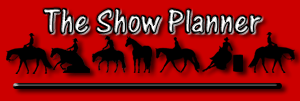 |
|
Show Horse Promotions Mary Murray
|
Slobbering in LegumesI have heard many people talking about problems with horses slobbering while grazing a variety of forages in addition to clover. I wanted to include this to try to clear up some of the misconceptions about slobbering. The classical slobbering syndrome, caused by ingestion of slaframine, can occur on all legumes, not just clover and alfalfa. The condition incorrectly has been solely attributed to red clover. However, all clovers, including Ladino have the capabilities of harboring the fungus during periods of high moisture. Horses grazing in pastures containing high levels of lespedeza and minimal amounts of ladino clover have encountered major slobbering problems during drought conditions! Apparently, continual short grazing just above ground level maintains a constant moisture content on the lespedeza leaflets which in turn produce the fungus that generates slaframine. The spots will appear as uncentrentric brown, golden or black rings. When ingested, the slaframine activates the salivary glands. Removal of the affected forage will stop the slobbering. Unfortunately, if slaframine intake continues, the horse can produce as much as 12=15 gallons of saliva daily which would cause severe dehydration and possibly death. This condition is especially serious in periods of high temperature and humidity. Although the dehydration symptoms can be treated, there is not treatment for slaframine except to eliminate it from the diet. Pasture management does play an important role in minimizing the occurrence of slobbering. Management practices include:
Ben E Chase
© 2000 - 2010 Show Horse Promotions The Show Horse Promotions web site is an informational web site, this information is subject to change without notice. Any use of, or actions taken based upon any of the information contained on this web site is done entirely at your own risk. Show Horse Promotions expressly prohibit you from republishing or redistributing this content without first receiving our written consent. By using this site, you agree not to hold us liable for any errors or delays in this content, or for any actions that you take in reliance thereon. This site contains links to other Internet sites. These links are not endorsements by us of any products or services in those sites, and we have not endorsed or approved any information in those sites. |
|
||||||||
